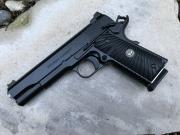I have one one of what I term the "big butt" Gen 3 G21s; an early 2000s production non-SF G21. Mechanically, its been an absolutely superb performer, in the thousands of rounds fired through it, I literally can recall only one malfunction, and that was with a grossly deformed bullet on a Winchester White Box cartridge that was probably at least .046 in diameter.
However, due to its girth, out of all my Glocks, the G21 provides the greatest challenges to me in terms of achieving fast and accurate results. Part of the "fast" equation is doubtlessly attributable to the characteristics inherent to the 230 grain factory standard ammunition that I train with and carry, but grip size, sights, triggerfinger position, and action characteristics all come into play.
Initially, the gun was run with not unreasonable results with the OEM triggerbar and standard connector, Glock sights (albeit the OEM polymer ones were replaced with a set of Glock steel sights), and a extended slide stop/release (as produced for the G37). Although I'd personally experienced zero issues, the triggerbar was replaced around 2006 in conjunction with the LAPD-initiated (and shortly thereafter standardized production) upgraded triggerbar. A segment of mountain bike innertube was placed on the receiver to prived greater grippiness, particularly with sweaty hands. A Glock "dot" connector replaced the OEM standard connector, providing a slightly lighter triggerpull. About a year ago, I also standardized all my Glocks with a Pierce butt-plug.
My times remained relatively slow, particularly as measured by my GSSF performances with the gun in comparison to my other 9mm Glocks used-G17, G19 and G34, where my G21 consistently performed with lower accuracy and speed-especially slower speeds.
The sights were upgraded several years ago to a set of Warren/Sevigny Carry sights, with no significantly increased performances resulting (but I do like the sights, and they're remaining on the gun). I then decided to try something counter-intuitive-while keeping the "dot" connector, replacing the coil triggerspring with a NY2, to provide a heavier, more revolver-like, but essentially single-stage trigggerpull, and crisp, discernible reset. Dry- and live-fire (square-range) results were encouraging.
However, running the G21 thus equipped at the recent Dundee OR GSSF match in conjunction with my Gen 3 G17 (with OEM triggerbar/connector, Glock steel sights, extended Glock Slide Stop/Release was quite illuminating. In short, with the G17, as I shot through successive strings of fire, my speed decreased and accuracy either increased or at least remained constant. With the NY2/dot-connectored G21, speed decreased and accuracy concurrently decreased as I shot through consecutive strings of fire. The message I'm clearly getting is that the benefits of the heavier NY2 quickly reaches a diminishing point of return, and that I was fighting against the trigger, causing decreased speeds and accuracy. For the first magazine, everything was relatively-hunky dory, but triggerpull degradation occurred in short order.(Speed was fine for the first string, but began to pretty precipitously increase with the second, and even more markedly with the 3rd and 4th magazine). Accuracy degradation was pronounced on the 4th magazine of firing; otherwise it was actually fairly decent up to that point.
However, I like the basic triggerpull characteristics (minus the overly heavy triggerpull weight) that a NY spring provides. I like the single-stage pull, and crisp, perceptible and quickly achieved trigger reset point. So-out with the NY2 and in with a NY1, but still remaining with the "dot" connector. If that combo needs more tuning, I'll probably switch the "dot" connector with a "minus" one; the "dot" connector reportedly decreases the triggerpull weight by about 1/2 lb from the "standard" connnector, essentially providing a middle-of-the-road approach between the "standard" and "minus" connectors, especially regarding Gen 3 Glocks; and Gen4s, it's now the OEM connector, and Glock has tightened up their relative availability to the general public for application to non-Gen4 Glocks, making it similar to their restricted availability approach regarding "minus" connectors.
And yes, I've comparatively shot a Gen 3 G21 SF and a Gen4 G21 without additional gripstraps. They felt nice, but performance with my venerable Gen 3 G21 was superior, at least for me (and quite possibly significantly influenced by my familiarity and muscle-memory built up on the Gen G21), so I'm disinclined to shift out of my Gen 3 G21 to a later G21 SF or Gen4 G21.
I'll report as to how I do with the NY1/dot connector, and possibly with a NY1/minus connector. Feel free to chip in with any commentary.
Best, Jon




 Reply With Quote
Reply With Quote



